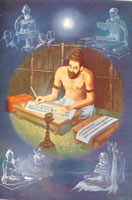|
| In
the later Vedic works called the Brahmanas and the Aranyakas
written mostly in prose, followed the Vedic hymns. There
are six systems of orthodox Hindu thought. They are Samkhya,
the Yoga, the Nyaya, the Vaisesika, the Mimamsa (Purva mimamsa)
and Vedanta (Uttar Mimamsa). Samkhya and Yoga are different
schools of one system. The Vaisesika and the Nyaya in later
times became so mixed up that initailly Vaisesika had similarity
with Mimamsa but it became so mixed with Nyaya that they
have been treated together. In addition to these systems
some theistic systems began to grow prominent from the ninth
century AD. They had their early beginning at the time of
the Upanisads. |
 |
One of their most important early works is the Bhagavadgeeta.
This is rightly regarded as one of the greatest masterpieces
of Hindu thought. It is written in verse, and deals with moral,
religious and metaphysical problems. In a loose form its lack
of system and method gives it its peculiar charm more akin to
the poetry of the Upanisads. From the ninth century onwards
attempts were made to supplement these loose theistic ideas.The
Samhitas are
collection of verses ('sam' means together, 'hita' means to
put). There are four collections or Samhitas namely Rig veda,
Sama veda, Yajur Veda and Atharva Veda.
The
Brahmanas
were theological treatise written in prose. They explain sacred
significance of the different rituals. These works are full
of dogmatic assertions, fanciful symbolism and speculations
of an unbounded imagination in the field of sacrificial details.
The period is believed to be 500 BC.
Aryanakas
or
forest treatise wherein intelligent people the ritualistic ideas
began to give away and philosophic speculations about the nature
of the truth was gradually substituted. Free thinking tried
gradually to come out of ritualism paved way for Upanishads.
There
are more than
100 Upanishads. Some of them were written at later times, as
late as fourteenth century. The Upanishads are also known as
Vedanta as they are believed to be the later portions of the
Vedas. They retained their Vedic names and lineage . The Upanisads
attached to the Brahmanas of the Aitareya are called as Aitareya
Upanisads.
All
these literatures were looked upon as so holy that in the early
times that it was thought almost a sacrilege to write them.
Hence they were propagated by memorising by heart and mouth
to mouth. Hence it was a knowledge that is heard. Hence they
were called as Sruti.
|